Main page
The goal of this project is obtaining new fundamental knowledge about the gradual or impulsive release of the free magnetic energy in Active Regions (ARs) at the Sun. The role of these energy release processes is central for all of the solar activity as well as the key for many astrophysics and space plasmas. The goal of the project is achieved via (a) creation of realistic consistent three-dimensional (3D) magneto-plasma models of the corona and chromosphere above active regions; (b) computation of the electromagnetic radiation produced from these models in a broad spectral domain from the radio waves to X-rays and gamma-rays; (c) quantitative use of these models and simulation tools for a detailed analysis of the ARs and solar flares.
The database of these realistic models is made freely available via this web-site and will be populated as the project progresses.
News
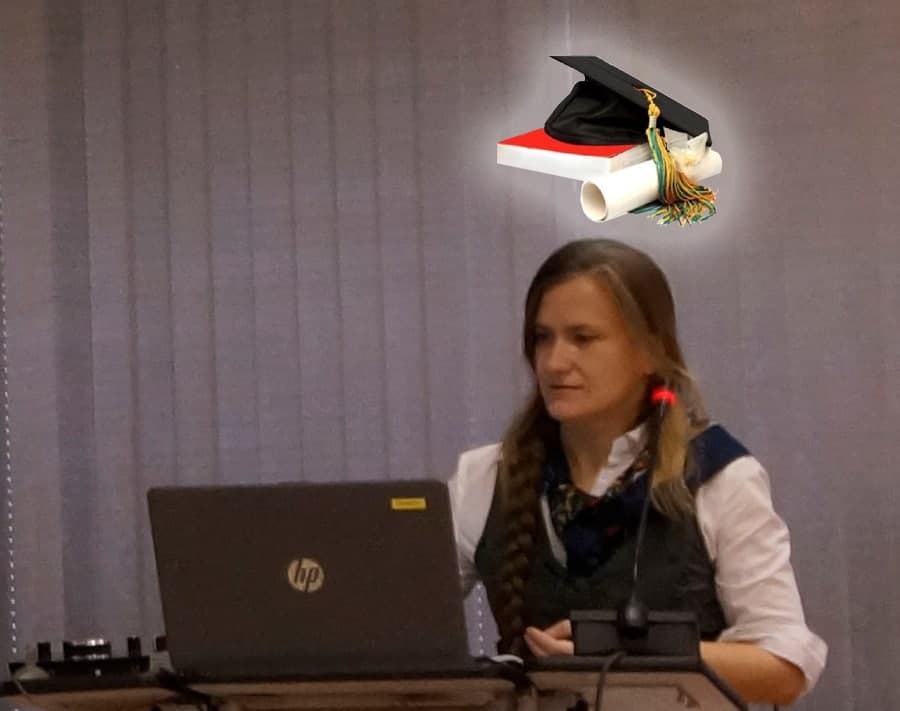
03 November 2020: Our team member, Alexandra Lysenko, gets her PhD Degree. Congratulations, Alexandra!
- Alexandra defended her thesis entitled “Impulsive acceleration of particles in solar flares and their role in plasma heating” at Space Research Institute of the Russian Academy of Sciences on 2020-Nov-03. Her work was supported by official reviews from Drs. V. F. Melnikov and B.Yu. Yushkov, mail-in reviews from Drs. A.A. Kuznetsov, A.G. Kosovichev, V.G. Kurt and S.I. Petuchov, who spoke strongly in her support.
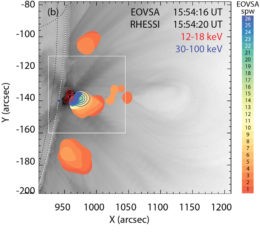
15 August 2018: The AAS Nova published a Highlight Article by Susanna Kohler “Microwaves from Solar Flares”.
- The article features the paper “Microwave and Hard X-Ray Observations of the 2017 September 10 Solar Limb Flare” by D. E. Gary, B. Chen, B. R. Dennis, G. D. Fleishman, G. J. Hurford, S. Krucker, J. M. McTiernan, G. M. Nita, A. Y. Shih, S. M. White, which reports the first science results from the newly completed Expanded Owens Valley Solar Array (EOVSA). EOVSA obtained excellent microwave imaging spectroscopy observations of SOL2017-09-10, a classic partially occulted solar limb flare associated with an erupting flux rope.
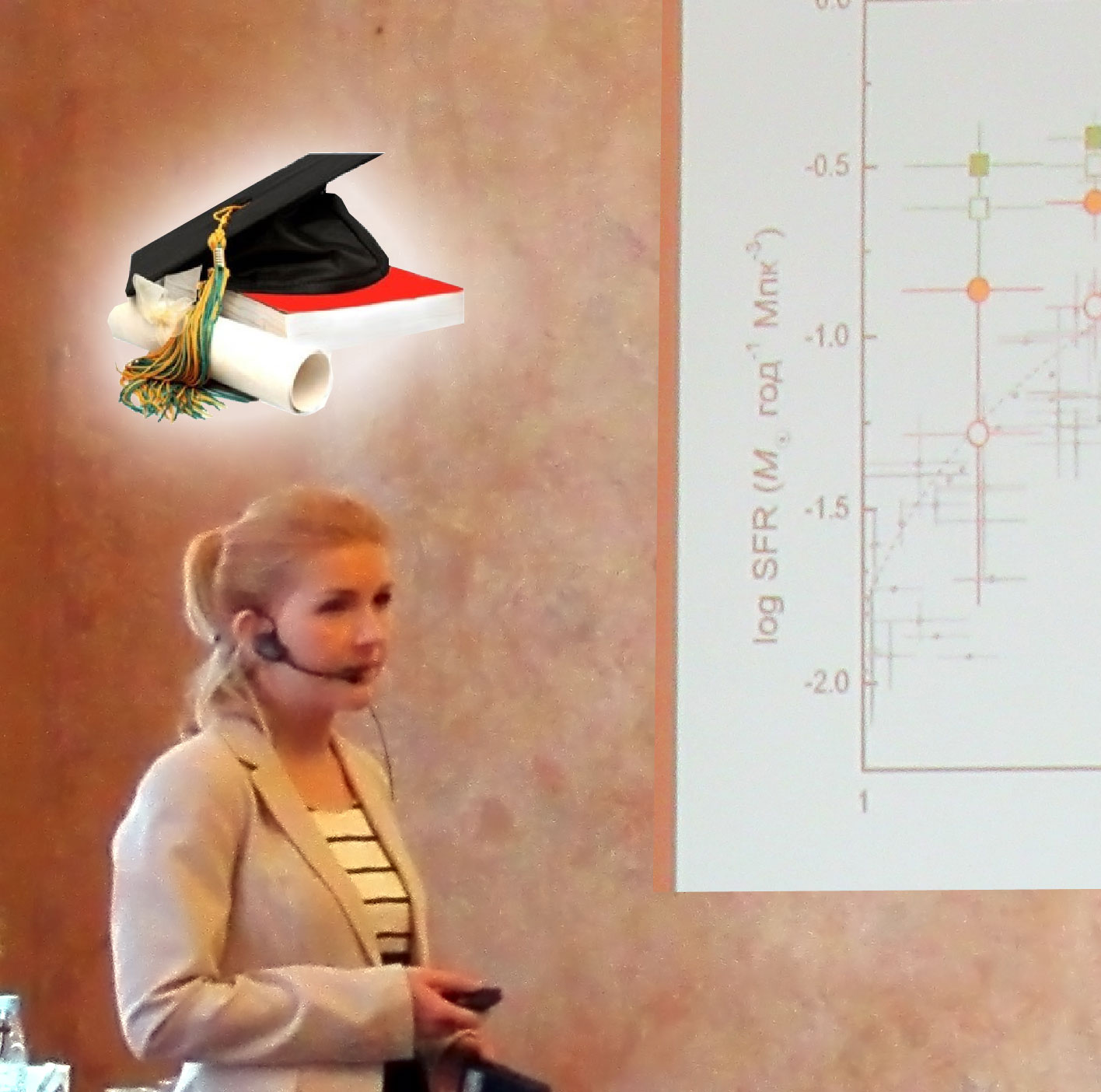
05 June 2018: Our team member, Anastasia Tsvetkova, gets her PhD Degree. Congratulations, Anastasia!
- Anastasia defended her thesis entitled "Konus-Wind observations of gamma-ray bursts with known redshifts" at Ioffe Institute of the Russian Academy of Sciences on 2018-Jun-05. Her work was supported by official reviews from Dr. S. I. Blinnikov and Prof. S. Yu. Sazonov, mail-in reviews from Drs. G. M. Beskin, A. V. Blinov and M. Yu. Piotrovich, and the members of the Russian Academy of Sciences, Professors D. A. Varshalovich and A. V. Ivanchik, who spoke strongly in her support.
The decision to award Anastasia PhD degree was adopted by the members of the scientific council unanimously. We congratulate Anastasia and wish her further success in her research.
03 May 2018: NJIT press-release: “Why Does the Corona Sizzle at 1 Million °F? NJIT's Gregory Fleishman is Unearthing Clues” highlights the paper “Ion Traps at the Sun: Implications for Elemental Fractionation” by G. Fleishman et al.
- The press-release has been followed up by many resources, iflscience.com and phys.org.

30 April 2018: NEW educational resources have been launched at our web site.
- Class Room includes a collection of introductory lectures and associated home works. This includes IDL Getting Started, SSW installation & Widget Examples including GX Simulator, Emission Mechanisms and Radiation Transfer, Making Video in IDL, and 3D Model Production Conveyer.

- A regular Solar Physics Webinar of Global Reach (SPW-GR) invites the entire solar physics community to participate. The target audience is active researchers in all areas of Solar Physics including graduate students. The Webinar uses the Cisco Webex service available at NJIT and is coordinated by Dr. Gregory Fleishman. The Webinar will initially run on a monthly schedule starting Wednesday, April 18, and then each fourth Wednesday henceforth, but will likely switch to a biweekly schedule later. The Webinar will start at 14:00 UT, which is the only possible slot appropriate (at least marginally) for participants all the way from US west coast eastward to East Asia.
30 March 2018: LESIA—Observatoire de Paris, in NEWS (in French): “Des pièges à ions multichargés dans la Couronne solaire”
- The news presents the paper “Ion Traps at the Sun: Implications for Elemental Fractionation” by G. Fleishman et al.
20 March 2018: RFBR awarded Alexandra Lysenko (PI) and Galina Motorina (I) with a grant entitled “Multiwavelength Study of Strong Solar Flares during the Minima of Solar Cycles 22, 23, and 24” in the category “My First Grant” for young scientists.
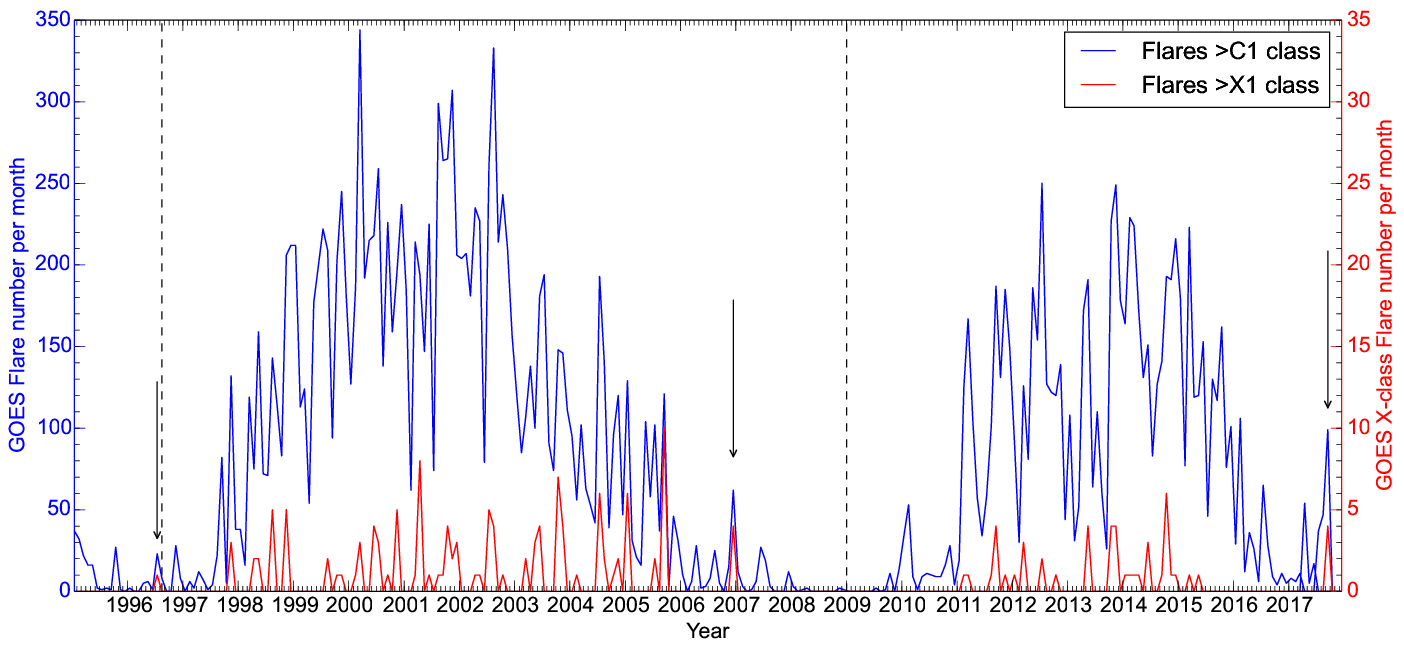
- This work is targeted on multiwavelength study and modeling of X-class flares that occurred during declining phases of 22, 23 and 24 solar cycles. The project will attempt to determine the fundamental causes of these powerful events to occur at the declining phase of solar cycles, and to draw conclusions about the likelihood and favorable conditions for such powerful flares to happen during the minima of solar activity in the future.
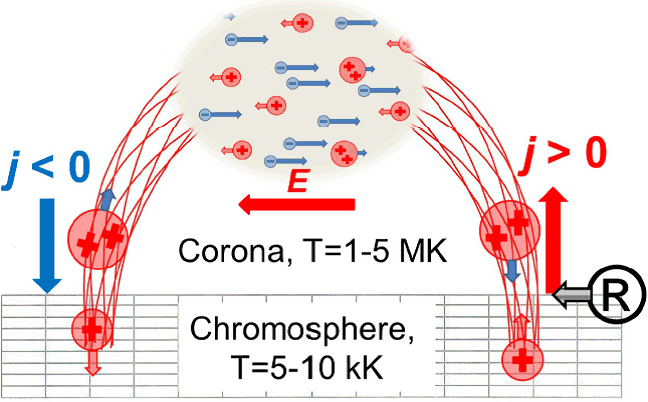
13 March 2018: The New Scientist Magazine published an Article by Anil Ananthaswamy “The sun’s mysteriously hot corona may be due to invisible plasma”
- The article features the paper “Ion Traps at the Sun: Implications for Elemental Fractionation” by G. Fleishman et al., which theoretically predicts and report the observational discovery of substantial concentrations of heavy ions in current-carrying magnetic flux tubes.
06 March 2018: CESRA published a HIGHLIGHT “Dressing the Coronal Magnetic Extrapolations of Active Regions with a Parameterized Thermal Structure” by Gelu M. Nita et al.
- The publication highlights a recent paper “Dressing the Coronal Magnetic Extrapolations of Active Regions with a Parameterized Thermal Structure”, which reports a major enhancement of the IDL-based simulation tool, GX_Simulator, previously developed for modeling microwave and X-ray emission from flaring loops, to allow it to simulate quiescent emission from solar ARs. The framework includes new tools for building the atmospheric model and enhanced routines for calculating emission that include new wavelengths.

Example of EUV synthesized images to observed data comparison for AR 11072 on 23-May-2010.
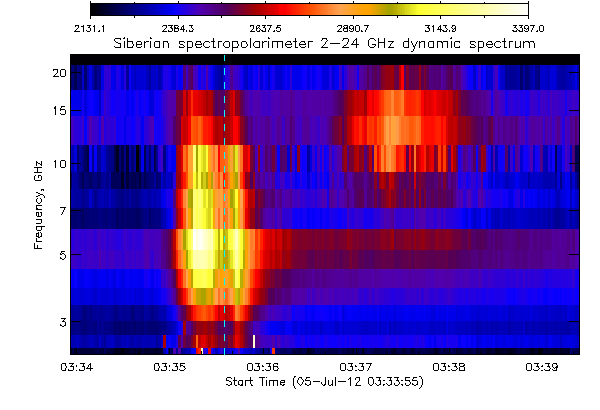
27 December 2017: The database of the events observed simultaneously by Konus-Wind and Siberian Solar Radio Telescope and/or Siberian Spectropolarimeter was added to the project.
- Currently, it contains 207 flares, including 178 events with available microwave images of the Sun (note that due to the lower temporal resolution of the SSRT some images might be obtained slightly before or after the Konus-Wind flare) and 46 events with available microwave dynamic spectra (partially calibrated).
15 November 2017: A paper entitled "Imaging spectroscopy of solar radio burst fine structures" was published in Nature Communications.
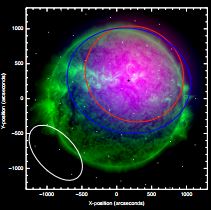
- A team of researchers (including the project participant Alexey Kuznetsov) presented new observations of a solar type IIIb burst with one of the largest radio telescopes, the LOw Frequency ARray (LOFAR). LOFAR provides radio images in metric wavelength range with unprecedented temporal and spectral resolution, which literally enables one to track how the radio emission propagates through the solar corona. The results obtained indicate that the observed locations and sizes of the low-frequency radio emission sources are determined by the radio wave propagation effects (i.e., scattering on small-scale plasma fluctuations) rather than by the intrinsic properties of the sources.
24 October 2017: CESRA published a HIGHLIGHT “Flare SOL2012-07-06: on the origin of the circular polarization reversal between 17 GHz and 34 GHz” by Altyntsev et al.
- The publication highlights a recent paper that analyses possible causes for the sign reversal of circular polarization from the flare source emission between 17 GHz and 34 GHz. It is established that this sign reversal at 17 GHz is due to the wave passing through a quasi-transverse (QT) layer located reasonably low, below 5 Mm, in the solar corona. This same QT layer is also responsible for the sign reversal of the steady gyroresonance emission from this active region (AR) as illustrated by the Figure.

Evolution of AR emission at 17 GHz. The grayscale background is the intensity. Contours correspond to RCP (solid) and LCP (dashed) emission. Levels 0.1, 0.5, and 0.9 are relative to the corresponding brightness maximum. Coordinates are given in arcseconds from the solar center.

20 October 2017: Our team member, Galina Motorina, gets her PhD Degree. Congratulations, Galina!
- Galina defended her thesis entitled “Dynamics of plasma heating and energy distributions of flare-accelerated electrons based on X-ray and ultraviolet data” at The Central Astronomical Observatory of the Russian Academy of Sciences at Pulkovo on 2017-Oct-20. Her work was supported by official reviews from Drs. Ostryakov and Zimovetz, mail-in reviews from Drs. Altyntsev, Gordovskyy, and Melnikov, and Dissertation Council members, Drs. Bogod and Nagovitsyn, who spoke strongly in her support. We wish Galina further success in her science career. Good luck!
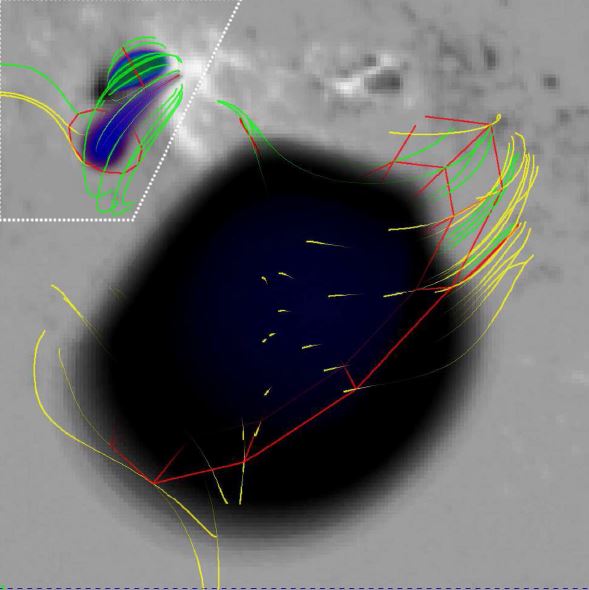
19 September 2017: CESRA published a HIGHLIGHT “EUV-invisible reservoir of solar energetic particles” by G. Fleishman et al.
- The publication highlights a recent paper “A Large-scale Plume in an X-class Solar Flare”, which reports a discovery of a large-scale magnetic structure filled with plethora of nonthermal electrons but having a very tiny thermal plasma component. As a result, this structure is detected in the microwave range, but entirely invisible in EUV and X-ray ranges. The 3D model of the flare and associated data are available at our site.
10 September 2017: Our team broadly presents the project outcomes at international scientific meetings
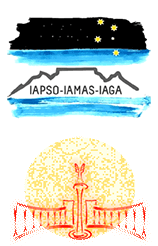
- Five team members attended the 2017 Joint IAPSO-IAMAS-IAGA Assembly in Cape Town, South Africa, 27 August to 1 September 2017, where two invited talk and five contributed talks were given. Four team members attended European Solar Physics Meeting in Budapest, Hungary, 04—08 September 2017, where one invited talk and three contributed talks and poster were presented. All key topics of our project were covered: 3D modeling of solar flares, Konus-Wind X-ray / gamma-ray data, development and testing of the coronal magnetic field reconstructions including account of constraints at the chromospheric heights, gyroresonant coronal magnetography, and overview of the of the 3D model repository available at the project web site.
22 August 2017: KW-Sun: Konus-Wind HXR and Gamma-ray Solar Flare Database – All Data Are On-line
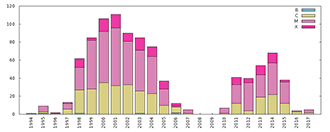
- KW-Sun is the database of solar flare observations in HXR and soft gamma-ray ranges by Konus-Wind instrument. Konus is a Russian instrument onboard the US Wind spacecraft launched on November 1, 1994 for gamma-ray burst and solar flare studies. The spacecraft is located in the interplanetary space (since July of 2004 – near Lagrange point L1), so the instrument sees the Sun 24 hours a day. Data registered by Konus-Wind in the triggered mode constitute the presented database. KW-Sun provides light curves with high temporal resolution (down to 16 ms) and energy spectra in wide energy range (now ~20 keV – 15 MeV) which covers the region of non-thermal emission from electrons and ions accelerated in solar flares.
- Konus-Wind / KW-sun team is pleased to announce that the data for all solar flares registered by the Konus-Wind instrument in the triggered mode over more than two solar cycles since the launch till the present time are published on-line and can be accessed via http://www.ioffe.ru/LEA/kwsun. In particular, the data from 15+ years overlap with RHESSI lifetime are available. Detailed description of the provided data can be found at the database website http://www.ioffe.ru/LEA/kwsun/kw-info.html.
- New solar observations will be added to the database as soon as they arrive.
10 August 2017: Our team takes part in 25% of the ALMA solar proposals selected for Cycle 5
- About 20 solar proposal were selected for ALMA Cycle 5 with grades A, B, or C. 16 of them are the highest ranked proposals (grades A or B), where solar proposals belong to Category 50=Stellar evolution and the Sun. Our team members, Maria Loukitcheva and Gregory Fleishman, are the PIs or Co-Is on five of them:
- Probing the chromosphere of coronal holes and coronal hole boundaries, grade B - PI Maria Loukitcheva;
- Investigating the sunspot umbra and its millimeter brightening, grade B - PI Kazumasa Iwai (Co-I Maria Loukitcheva);
- Chromospheric brightness and the magnetic field in solar active regions, grade B - PI Hardi Peter (Co-I Maria Loukitcheva);
- Short-term Variability of the Chromospheric Thermal Structure in Active Regions on the Sun, grade C – PI Gregory Fleishman;
- High-energy electrons in magnetic reconnection, grade C – PI Masumi Shimojo (Co-I Gregory Fleishman).
28 July 2017: NASA Selects Proposals to Study Sun, Space Environment
- NASA announced selection of a number of mission proposals for a phase A study. The most relevant to our project are:
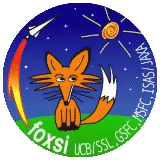
- Focusing Optics X-ray Solar Imager (FOXSI)
FOXSI is a solar-dedicated, direct-imaging, Hard X-Ray telescope that would detect hot plasma and energetic electrons in and near energy release sites in the solar corona. - Sun Radio Interferometer Space Experiment (SunRISE)
SunRISE will consist of a constellation of cubesats operating as a synthetic aperture radio telescope to address the critical heliophysics problems of how solar energetic particles are accelerated and released into interplanetary space.
- Focusing Optics X-ray Solar Imager (FOXSI)
10 June 2017: Expanded Owens Valley Solar Array (EOVSA) has started to produce images.
- EOVSA has started producing high-resolution (3” at 18 GHz) multi-frequency radio images of the solar flares, active regions, and the full sun; see examples of flare images below. Movies of the microwave source evolution show interesting dynamics in time and also significant variation of the source structure with the emission frequency.
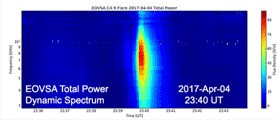
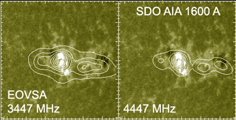
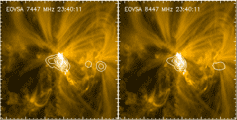
- The figure (left most panel) shows the dynamic spectrum for a large flare on 2017-Apr-04. Multifrequency images (contours) are shown overlaid on SDO images in the other panels. The lower-frequency contours are shown on top of SDO 1600 Å image, while the higher-frequency contours on top of SDO/AIA 171 Å image that shows the hot coronal loops joining the sunspots. The contours show a progression from a large source covering the entire sunspot region toward smaller, more isolated sources as the frequency increases (credit: Dale Gary).
2 May 2017: An Article by M. A. Loukitcheva et al. has been selected as an A&A Highlight.
- An Article "Millimeter radiation from a 3D model of the solar atmosphere. II. Chromospheric magnetic field" by M. A. Loukitcheva et al. has been selected as an A&A Highlight. For A&A Highlights, A&A Editors select particularly interesting papers published in a given volume. The Highlight about the article has been written by the associate editor, Dr. Hardi Peter, who handled it. Details are also published on the A&A twitter account @aanda_journal.

- Longitudinal component of the magnetic field, Bz, restored from the synthetic brightness temperature and polarization maps, and taken directly from the model at the effective formation heights of the radiation at 3.2 mm and 1.3 mm
20 April 2017: Dr. Nita posted a major GX Simulator upgrade on SSW.
- The update may be installed using the standard SSW upgrade IDL routines, or directly from the above link.
- The main new features of the upgraded tool include ability to produce a ‘Combo’ model, which integrates, in one single data cube, both coronal and chromospheric volumes, and the ability to render such irregularly gridded volume from any LOS direction. To handle the radiation transfer along the line-of-sights with variable voxel height, the computational plug-ins were updated accordingly. This new update also includes countless improvements of the model handling and transformation tools, model-to-data comparison tools, new or improved radiation transfer plug-ins, and new look up tables for the AR thermal modeling. The tool now treats the FOV maps and bottom-of-the-cube maps differently, which facilitates the best possible co-alignment between the observational and synthesized maps.
27 March 2017: A Letter entitled "High-resolution observations of flare precursors in the low solar atmosphere" was published in Nature Astronomy.
- A team of researchers published new, high-resolution data on a solar flare 2015-06-22 observed jointly by NST/BBSO in the optical and EOVSA in the radio, augmented by analysis thereof with the new methods supplied by the project PI, Gregory Fleishman. Among other findings the paper reports the first ever derived evolution of the coronal flare magnetic field with 1 second time resolution. Read Press-release.
21 March 2017: Call for Cycle V ALMA proposals is now open
- The ALMA Director, on behalf of the Joint ALMA Observatory (JAO) and the partner organizations in East Asia, Europe, and North America, is pleased to announce the ALMA Cycle 5 Call for Proposals (CfP) for scientific observations to be scheduled from October 2017 to September 2018. It is anticipated that 4000 hours of the 12-m Array time and 3000 hours of the Atacama Compact Array (ACA) time, also known as the Morita Array, will be available for successful proposals from Principal Investigators (PIs) in Cycle 5.
- The proposal submission deadline is 20-Apr-2017.
17 January 2017: ALMA Starts Observing the Sun
- New images from the Atacama Large Millimeter/submillimeter Array (ALMA) reveal stunning details of our Sun, including the dark, contorted center of an evolving sunspot nearly twice as large as the diameter of the Earth. These images are part of the testing and verification campaign to make ALMA's solar observing capabilities available to the international astronomical community.
20 November 2016: RHESSI nugget about KW-Sun database was published
- KW-Sun: The Konus/WIND hard X-ray solar flare database provides energy spectra and response matrices in FITS format as well as light curves in ASCII and IDL SAV formats for solar flares detected in the triggered mode. The IDL routine for reading and processing Konus/WIND FITS spectrum files has been added to the OSPEX package and is now available from SolarSoft.

